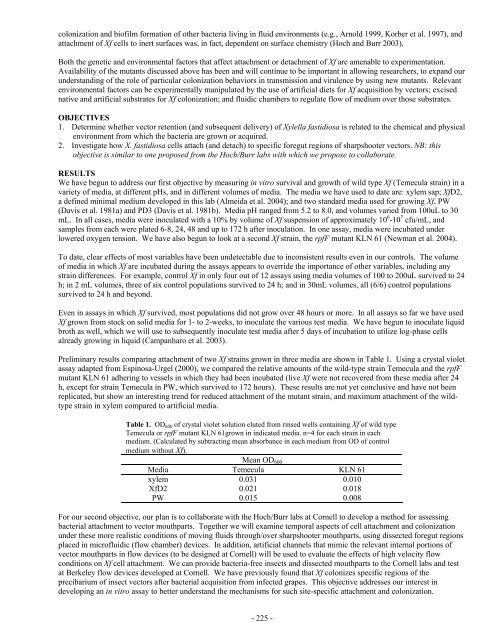Impact Of Host Plant Xylem Fluid On Xylella Fastidiosa Multiplication ...
Impact Of Host Plant Xylem Fluid On Xylella Fastidiosa Multiplication ...
Impact Of Host Plant Xylem Fluid On Xylella Fastidiosa Multiplication ...
You also want an ePaper? Increase the reach of your titles
YUMPU automatically turns print PDFs into web optimized ePapers that Google loves.
colonization and biofilm formation of other bacteria living in fluid environments (e.g., Arnold 1999, Korber et al. 1997), and<br />
attachment of Xf cells to inert surfaces was, in fact, dependent on surface chemistry (Hoch and Burr 2003).<br />
Both the genetic and environmental factors that affect attachment or detachment of Xf are amenable to experimentation.<br />
Availability of the mutants discussed above has been and will continue to be important in allowing researchers, to expand our<br />
understanding of the role of particular colonization behaviors in transmission and virulence by using new mutants. Relevant<br />
environmental factors can be experimentally manipulated by the use of artificial diets for Xf acquisition by vectors; excised<br />
native and artificial substrates for Xf colonization; and fluidic chambers to regulate flow of medium over those substrates.<br />
OBJECTIVES<br />
1. Determine whether vector retention (and subsequent delivery) of <strong>Xylella</strong> fastidiosa is related to the chemical and physical<br />
environment from which the bacteria are grown or acquired.<br />
2. Investigate how X. fastidiosa cells attach (and detach) to specific foregut regions of sharpshooter vectors. NB: this<br />
objective is similar to one proposed from the Hoch/Burr labs with which we propose to collaborate.<br />
RESULTS<br />
We have begun to address our first objective by measuring in vitro survival and growth of wild type Xf (Temecula strain) in a<br />
variety of media, at different pHs, and in different volumes of media. The media we have used to date are: xylem sap; XfD2,<br />
a defined minimal medium developed in this lab (Almeida et al. 2004); and two standard media used for growing Xf, PW<br />
(Davis et al. 1981a) and PD3 (Davis et al. 1981b). Media pH ranged from 5.2 to 8.0, and volumes varied from 100uL to 30<br />
mL. In all cases, media were inoculated with a 10% by volume of Xf suspension of approximately 10 6 -10 7 cfu/mL, and<br />
samples from each were plated 6-8, 24, 48 and up to 172 h after inoculation. In one assay, media were incubated under<br />
lowered oxygen tension. We have also begun to look at a second Xf strain, the rpfF mutant KLN 61 (Newman et al. 2004).<br />
To date, clear effects of most variables have been undetectable due to inconsistent results even in our controls. The volume<br />
of media in which Xf are incubated during the assays appears to override the importance of other variables, including any<br />
strain differences. For example, control Xf in only four out of 12 assays using media volumes of 100 to 200uL survived to 24<br />
h; in 2 mL volumes, three of six control populations survived to 24 h; and in 30mL volumes, all (6/6) control populations<br />
survived to 24 h and beyond.<br />
Even in assays in which Xf survived, most populations did not grow over 48 hours or more. In all assays so far we have used<br />
Xf grown from stock on solid media for 1- to 2-weeks, to inoculate the various test media. We have begun to inoculate liquid<br />
broth as well, which we will use to subsequently inoculate test media after 5 days of incubation to utilize log-phase cells<br />
already growing in liquid (Campanharo et al. 2003).<br />
Preliminary results comparing attachment of two Xf strains grown in three media are shown in Table 1. Using a crystal violet<br />
assay adapted from Espinosa-Urgel (2000), we compared the relative amounts of the wild-type strain Temecula and the rpfF<br />
mutant KLN 61 adhering to vessels in which they had been incubated (live Xf were not recovered from these media after 24<br />
h, except for strain Temecula in PW, which survived to 172 hours). These results are not yet conclusive and have not been<br />
replicated, but show an interesting trend for reduced attachment of the mutant strain, and maximum attachment of the wildtype<br />
strain in xylem compared to artificial media.<br />
Table 1. OD 600 of crystal violet solution eluted from rinsed wells containing Xf of wild type<br />
Temecula or rpfF mutant KLN 61grown in indicated media. n=4 for each strain in each<br />
medium. (Calculated by subtracting mean absorbance in each medium from OD of control<br />
medium without Xf).<br />
Mean OD 600<br />
Media Temecula KLN 61<br />
xylem 0.031 0.010<br />
XfD2 0.021 0.018<br />
PW 0.015 0.008<br />
For our second objective, our plan is to collaborate with the Hoch/Burr labs at Cornell to develop a method for assessing<br />
bacterial attachment to vector mouthparts. Together we will examine temporal aspects of cell attachment and colonization<br />
under these more realistic conditions of moving fluids through/over sharpshooter mouthparts, using dissected foregut regions<br />
placed in microfluidic (flow chamber) devices. In addition, artificial channels that mimic the relevant internal portions of<br />
vector mouthparts in flow devices (to be designed at Cornell) will be used to evaluate the effects of high velocity flow<br />
conditions on Xf cell attachment. We can provide bacteria-free insects and dissected mouthparts to the Cornell labs and test<br />
at Berkeley flow devices developed at Cornell. We have previously found that Xf colonizes specific regions of the<br />
precibarium of insect vectors after bacterial acquisition from infected grapes. This objective addresses our interest in<br />
developing an in vitro assay to better understand the mechanisms for such site-specific attachment and colonization.<br />
- 225 -











